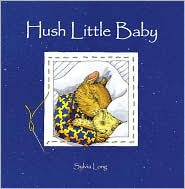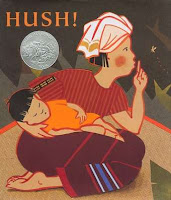An Ode to a baby
Lullaby - Etymology From Middle English lullen, to lull + bye. First recorded circa 1560, says an online resource.
Some lullabies, I think, are intentionally devoid of logic. Some are intelligently crafted to educate. While some are soaked in love, some others are plain funny. But interestingly most lullabies carry meaningful particulars of the land and its culture.
The books below are well enjoyed by my toddler and me, so much so that when read at times other than bedtime, he typically wants to at least lie down for a bit after our session.

Title: Hush Little Baby
Author & Illustrations: Sylvia Long
Published by: Chronicle Books
Disturbed by the materialistic attitude of the lyrics of the traditional American lullaby “Hush little baby†(http://en.wikipedia.org/wiki/Hush,_Little_Baby), award-winning artist Sylvia Long has reworked it for a more nature-centric version. This one oozes warmth and lulls the listener and singer, in the same stillness of the night that Mama bunny and her baby in the book share.
The adorable details in the ink-and-watercolor drawings of Long, still urges the eye to wander in search of them. Like carrot prints on the curtains, bunny doodles on the lampshade and a quilt with a patchwork of playful things. Mama bunny points out to some of nature’s wonders around her porch and bedroom ( a humming bird, a lightning bug, a shooting star, a cricket and finally the moon), before kissing goodnight to her baby.
I sometimes tend to think that this version might still leave some of us promising our child the impossible, but I resort to the fact that nothing can be more calming than nature’s precious little things. Or as Sylvia Long claims in her note to readers at the end of the book It seems much healthier to encourage children to find comfort in the natural things around them…

Title: A Norse Lullaby
Author: M.L.Van Vorst; Illustrator: Margot Tomes
Published by: Lothrop, Lee & Shepard Books
A Norse Lullaby. That was reason enough for me to bring this home from the library. The book gave me the story later. The lullaby first appeared in January 1897 in a children’s magazine. When illustrator Margot Tomes discovered it, she wanted to paint the wintry Scandinavian landscape herself to go with the lullaby.
A family awaits the arrival of the father. The father is rushing on a sled to the “warmth†that is waiting for him at home. The children are playing. A baby is trying to retire for the night. Hush Hush in your little nest, And mother’s voice is singing.
The artwork is amazing. The greys and whites of a snowed in landscape juxtaposed with the reds, browns and greens gives us that perfect feel of the far North and its culture. Details of a traditional household are aplenty. The wood in a barrel near the huge fireplace, the rocking reindeer toy, the hurricane lamps, the clothes, the small wooden crib all transport us to the home that stands amidst mounds of snow, with the wind whistling on a wintry evening.

Title: Hush – A Thai Lullaby
Author: Minfong Ho ; Illustrator: Holly Meade
Published by: Orchard Books
This book stole my heart. And my little boy’s. Sometimes even our sleep.
The setting is a very remote Thai village. With native flora and fauna generously encompassing the small hut, a mother goes great lengths to assure her child of the quietness she needs for a peaceful sleep.
A blue cloth hammock carries a baby. Traditional Thai basketry, prints, fabrics and architecture take us to a Thai household. The mother begins her rounds by hushing a mosquito. She moves on to the cat, the mouse by the rice barn, the leaping frog, the pig, duck, monkey, even an old water buffalo and even…even...the great big elephant! Not surprising considering what the illustrations portray. Cut paper and ink illustrations of lush forestry in warm earth tones and a bold orange-red outline makes the images come alive.
Interestingly, we notice the baby getting out of the hammock and wandering in the background, just as her mother turns her back to her. My own baby took upon himself the task of finding his counterpart’s tiny depiction in every page. It was also immensely refreshing to hear and make rather new animal sounds, “uut-uut†for the pigs , “ghap-ghap†for the ducks and “jiak-jiak†for the monkeys!
As all living creatures wind down, Mother is also falling asleep. However the closing spread shows the baby wide awake on the blue hammock! As for us, the onomatopoetic verses in question and answer format are sedating enough to go down.
While some sing it by rote, some others make it a bonding experience. But lullabies, from Scandinavia or Asia or from America, are all delightfully hypnotic. A mother’s care for her child’s sleep transcends cultures.
Pictures Courtesy: Author and Bookstore websites.
Some lullabies, I think, are intentionally devoid of logic. Some are intelligently crafted to educate. While some are soaked in love, some others are plain funny. But interestingly most lullabies carry meaningful particulars of the land and its culture.
The books below are well enjoyed by my toddler and me, so much so that when read at times other than bedtime, he typically wants to at least lie down for a bit after our session.

Title: Hush Little Baby
Author & Illustrations: Sylvia Long
Published by: Chronicle Books
Disturbed by the materialistic attitude of the lyrics of the traditional American lullaby “Hush little baby†(http://en.wikipedia.org/wiki/Hush,_Little_Baby), award-winning artist Sylvia Long has reworked it for a more nature-centric version. This one oozes warmth and lulls the listener and singer, in the same stillness of the night that Mama bunny and her baby in the book share.
The adorable details in the ink-and-watercolor drawings of Long, still urges the eye to wander in search of them. Like carrot prints on the curtains, bunny doodles on the lampshade and a quilt with a patchwork of playful things. Mama bunny points out to some of nature’s wonders around her porch and bedroom ( a humming bird, a lightning bug, a shooting star, a cricket and finally the moon), before kissing goodnight to her baby.
I sometimes tend to think that this version might still leave some of us promising our child the impossible, but I resort to the fact that nothing can be more calming than nature’s precious little things. Or as Sylvia Long claims in her note to readers at the end of the book It seems much healthier to encourage children to find comfort in the natural things around them…

Title: A Norse Lullaby
Author: M.L.Van Vorst; Illustrator: Margot Tomes
Published by: Lothrop, Lee & Shepard Books
A Norse Lullaby. That was reason enough for me to bring this home from the library. The book gave me the story later. The lullaby first appeared in January 1897 in a children’s magazine. When illustrator Margot Tomes discovered it, she wanted to paint the wintry Scandinavian landscape herself to go with the lullaby.
A family awaits the arrival of the father. The father is rushing on a sled to the “warmth†that is waiting for him at home. The children are playing. A baby is trying to retire for the night. Hush Hush in your little nest, And mother’s voice is singing.
The artwork is amazing. The greys and whites of a snowed in landscape juxtaposed with the reds, browns and greens gives us that perfect feel of the far North and its culture. Details of a traditional household are aplenty. The wood in a barrel near the huge fireplace, the rocking reindeer toy, the hurricane lamps, the clothes, the small wooden crib all transport us to the home that stands amidst mounds of snow, with the wind whistling on a wintry evening.

Title: Hush – A Thai Lullaby
Author: Minfong Ho ; Illustrator: Holly Meade
Published by: Orchard Books
This book stole my heart. And my little boy’s. Sometimes even our sleep.
The setting is a very remote Thai village. With native flora and fauna generously encompassing the small hut, a mother goes great lengths to assure her child of the quietness she needs for a peaceful sleep.
A blue cloth hammock carries a baby. Traditional Thai basketry, prints, fabrics and architecture take us to a Thai household. The mother begins her rounds by hushing a mosquito. She moves on to the cat, the mouse by the rice barn, the leaping frog, the pig, duck, monkey, even an old water buffalo and even…even...the great big elephant! Not surprising considering what the illustrations portray. Cut paper and ink illustrations of lush forestry in warm earth tones and a bold orange-red outline makes the images come alive.
Interestingly, we notice the baby getting out of the hammock and wandering in the background, just as her mother turns her back to her. My own baby took upon himself the task of finding his counterpart’s tiny depiction in every page. It was also immensely refreshing to hear and make rather new animal sounds, “uut-uut†for the pigs , “ghap-ghap†for the ducks and “jiak-jiak†for the monkeys!
As all living creatures wind down, Mother is also falling asleep. However the closing spread shows the baby wide awake on the blue hammock! As for us, the onomatopoetic verses in question and answer format are sedating enough to go down.
While some sing it by rote, some others make it a bonding experience. But lullabies, from Scandinavia or Asia or from America, are all delightfully hypnotic. A mother’s care for her child’s sleep transcends cultures.
Pictures Courtesy: Author and Bookstore websites.


